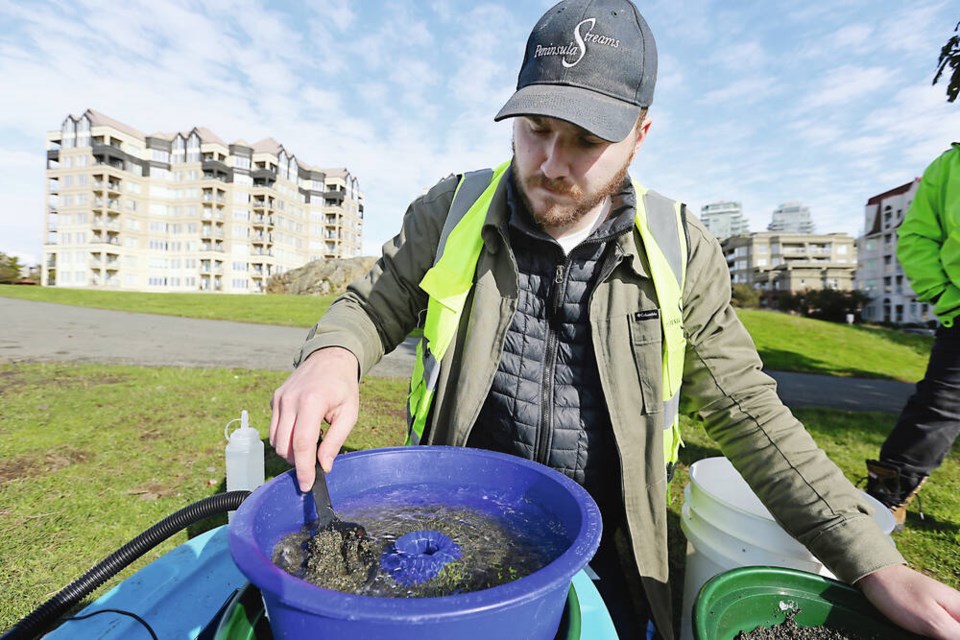Four surf smelt eggs — so tiny you need a microscope to spot them — have been found in Victoria Harbour’s Lime Bay, where habitat was recently restored to lure the silvery fish back.
It’s not many, but it was enough for biologists to celebrate. The mini eggs confirmed that the native forage fish, which is about 20 centimetres long, was spawning on the beach at the bay, between Spinnakers Brewpub and Victoria International Marina.
Project organizers hope to see not only surf smelt but Pacific sand lance spawn in the sand and pebbles introduced to the beach. The fish are important prey for salmon, which in turn are prey for other marine life, including orcas.
Fish eggs also serve as food for shorebirds — the harbour is part of a migratory bird sanctuary, where birds can stop to feed during their journeys. But much of it has been altered and polluted by heavy industry and development over the years. Areas where Lekwungen people once harvested food were filled in, and large rocks now line parts of the shoreline.
The addition of natural materials and recreation of the flatter beach of the past will allow small watercraft to land again at Lime Bay, where it was once common for Lekwungen people to bring their canoes.
The beach restoration project, now in its first phase, is a partnership between the Peninsula Streams Society, the Songhees and Esquimalt First Nations and the City of Victoria. It’s a demonstration project for the Pacific Salmon Foundation and B.C. Stewardship Centre’s Resilient Coast for Salmon program, as well as a trial to see how the gravel and sand that’s been added moves throughout winter storms.
In the spring, the plan is to excavate a little farther back to make room for smaller materials such as sands and lighter gravels. Large wood debris will anchor it, with boulders and native plants as well, potentially.
“We are trying to bring back a lot of the ecological values to the site,” said Kyle Armstrong, restoration co-ordinator for the Peninsula Streams Society. “These types of habitat have been lost to coastal development and are under threat.”
Before the work began, the beach consisted of angular large rocks installed to prevent erosion, plus old fill such as asphalt and concrete. There was no place for the fish to spawn, he said.
The fill was hauled out and “fish friendly” round small gravel in different sizes was put down to create a more natural habitat and appearance, Armstrong said.
It worked. Within three weeks, surf smelt eggs were identified, Armstrong said.
Biologists were back at Lime Bay this week to take samples from sand in another egg hunt. The sand is run through three sieves and swirled in a vortex. Water, hopefully containing eggs, is run through a filter. Samples are taken from the filter to be checked under a microscope.
Each egg measures about three-quarters of a millimetre, said Austin Nolan, a support biologist with Peninsula Streams.
Sampling is also starting for DNA studies, which will reveal what species of finned fish are living in the water, Armstrong said.
Eggs incubate between two to eight weeks. Most surf smelts will mature to spawn in their second year and may spawn again in the future, Armstrong said.
Like herring, they are believed to have some degree of homing and can live up to five years, he said.
There is little information on surf smelt stocks in the harbour, although it’s known that they were harvested in past years. The society is aiming to identify potential habitat for the fish, so they can be protected and better managed and understood.
Surf smelts are still caught with dip nets near Port Renfrew, Armstrong said.
Cecelia Dick (Xwulat), Songhees First Nation tourism supervisor with “Explore Songhees,” which offers walking and canoe cultural tours, says Lime Bay is part of the last village site of the Lekwungen people.
She says she would love to canoe to Lime Bay with visitors to “give them a better understanding of how vast our land was.”
Restoring the beach, she says, “brings back all the memories of our ancestors.”
“You take a look out there and see past all of the concrete that is here now and see what was here,” Dick said. “Our ancestors knew these lands so well. They only took what they needed.”



